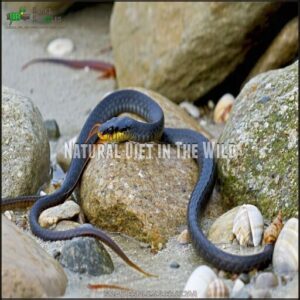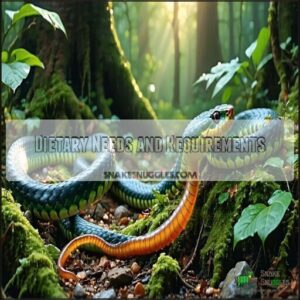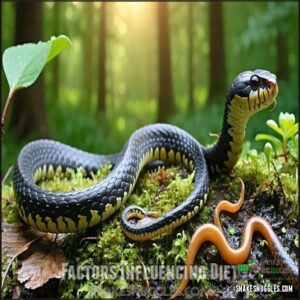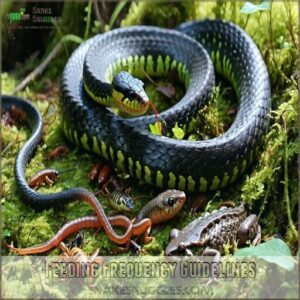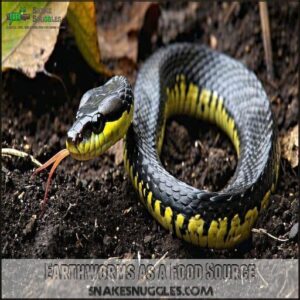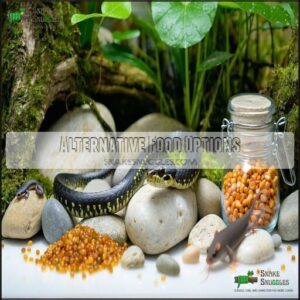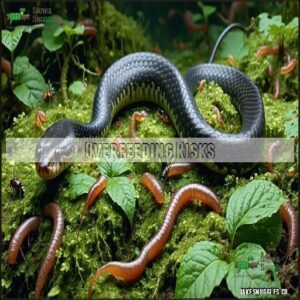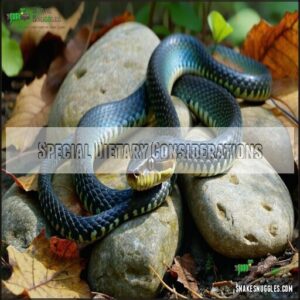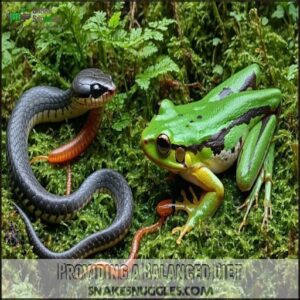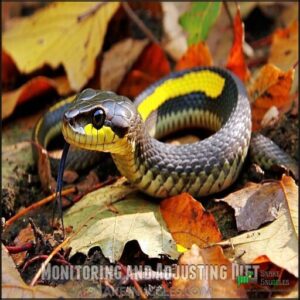This site is supported by our readers. We may earn a commission, at no cost to you, if you purchase through links.
 Ringneck snakes eat a wide variety of small, soft-bodied creatures that are easy for their tiny mouths to handle.
Ringneck snakes eat a wide variety of small, soft-bodied creatures that are easy for their tiny mouths to handle.
These include earthworms, slugs, and small amphibians like salamanders.
They’ve even been known to snack on insects and millipedes.
Their diet can vary depending on where they live—some might prefer worms in moist forests, while others lean toward lizards in drier habitats.
In captivity, ringneck snakes thrive on pre-killed worms or small feeder amphibians.
Just remember, they’re picky eaters and won’t chase live prey like larger snakes.
Curious about how their diet impacts their health and growth? Keep exploring this guide!
Table Of Contents
- Key Takeaways
- Natural Diet in The Wild
- Food Offerings in Captivity
- Dietary Needs and Requirements
- Factors Influencing Diet
- Feeding Frequency Guidelines
- Suitable Food Items
- Avoiding Common Feeding Mistakes
- Special Dietary Considerations
- Providing a Balanced Diet
- Monitoring and Adjusting Diet
- Frequently Asked Questions (FAQs)
- What can I feed my ringneck snake?
- What do ring-necked snakes eat?
- What animals eat ringnecks?
- Do ringneck snakes eat lizards?
- Do ringneck snakes eat frogs?
- Are ringneck snakes carnivores?
- What predators eat ring-neck snakes?
- Can you keep a ringneck snake as a pet?
- Will ringneck snakes bite?
- Are ringneck snakes good to have around?
- Conclusion
Key Takeaways
- Ringneck snakes mostly eat earthworms, slugs, and small amphibians like salamanders, adjusting their diet based on habitat and prey availability.
- In captivity, feed them small pre-killed prey like worms or feeder amphibians and maintain proper nutrition for optimal health.
- Dust prey with calcium and vitamin D supplements occasionally to support bone health and avoid nutrient deficiencies.
- Feeding frequency depends on age—juveniles eat more often than adults, while seasonal changes can affect appetite.
Natural Diet in The Wild
You’ll be surprised at the varied menu these tiny predators enjoy in their natural habitats, from earthworms and salamanders to slugs and even other small snakes.
These tiny predators feast on earthworms, salamanders, slugs, and even other small snakes, showcasing their adaptability in diverse habitats.
Their diet changes based on geographic location, with coastal populations consuming more marine invertebrates while woodland dwellers focus on amphibians and soft-bodied prey.
Primary Prey Sources
Nearly all ringneck snakes rely on three primary prey sources that form the foundation of their natural diet.
These slender reptiles have evolved specialized hunting techniques to capture small creatures in their woodland habitats.
When exploring what ringneck snakes eat in the wild, you’ll discover these main prey items:
- Earthworm Dependence – These soft-bodied invertebrates constitute up to 75% of their diet in many regions, providing essential proteins
- Salamander Consumption – Particularly red-backed varieties, which ringnecks track through leaf litter using their excellent sense of smell
- Slug Predation – These slow-moving mollusks offer nutritional benefits despite their mucous coating
Beyond these staples, ringneck snake prey includes small frogs, lizard intake of juvenile skinks, and occasional snake cannibalism of hatchlings from other species.
They play a crucial ecological role in their environment.
Their mild venom works effectively to subdue these prey items before swallowing them whole—a remarkable adaptation for such a small predator.
Geographic Variation in Diet
While ringneck snakes share similar hunting strategies across North America, what’s on their menu varies dramatically by location.
The geographic diversity in their diet reflects their impressive adaptability to different environments.
Regional prey availability creates distinct feeding patterns:
- Michigan populations of eastern ringneck snakes focus almost exclusively on red-backed salamanders, showing a specialized diet preference.
- Prairie ringnecks depend heavily on earthworms, which make up nearly their entire diet in these grassland regions.
- Florida’s Key ringneck snakes consume a broader variety of prey including small amphibians, lizards, insects, and slugs.
Habitat influence extends beyond just food type—eastern populations generally target smaller prey like salamanders and skinks, while western ringnecks hunt larger meals.
Even coastal invertebrates become regular menu items for snakes living near shorelines.
These snakes are often found in rocky habitats near water.
This dietary adaptation guarantees ringneck snakes can thrive across their extensive range.
Food Offerings in Captivity
You’ll need to offer your captive ringneck snake small prey items like earthworms, mealworms, and slugs that mimic their natural diet, with food dusted in calcium supplements 2-3 times weekly.
Feeding these small serpents every 3-5 days maintains proper nutrition.
But you’ll notice decreased appetite during colder months when their metabolism naturally slows, which can be a natural part of their cycle.
Suitable Food Options
After observing ringneck snakes in their natural habitats, you’ll want to replicate their diet in captivity with appropriate food options. Your ringneck snake’s menu should include items they’d naturally hunt, such as earthworms, mealworms, and other small creatures.
The following table outlines some food options for ringneck snakes:
| Food Item | Preparation Method |
|---|---|
| Earthworms | Rinse thoroughly |
| Mealworms | Gut-load 24hrs before |
| Crickets | Dust with calcium |
| Small slugs | Pre-killed only |
| Pinkie parts | Frozen then thawed |
Store-bought prey is safer than wild-caught options, which might harbor parasites. Many keepers source convenient frozen rodents for their snakes. When sourcing food, choose pre-killed prey that matches your snake’s mid-body width to ensure a healthy diet.
For ringneck snake diet variety, alternate between insects and amphibians weekly. Many keepers find that their snakes show preferences—some enthusiastically accept frozen options while others only strike at live prey, making it essential to provide a varied menu.
Feeding Frequency and Quantity
According to the needs of your ringneck snake, establishing an appropriate feeding schedule guarantees long-term health and well-being.
Your feeding frequency should align with your snake’s age:
- Baby ringnecks (0-6 months) – Offer small meals every 3-4 days, with prey items no larger than half their mid-body width
- Juveniles (6-18 months) – Provide juvenile portions every 5-7 days as their growth rate stabilizes
- Adults – Maintain adult frequency of one meal every 7-10 days with ideal quantity matching their mid-body diameter
For proper ringneck snake diet management, always adjust meal size based on your pet’s response. To promote proper nutrition, whole prey is important for providing essential nutrients.
If your snake leaves food uneaten, you’re likely overfeeding. Conversely, if it seems constantly searching for more, increase feeding frequency slightly. Remember that seasonal changes may affect your snake’s appetite, so be flexible with your snake feeding schedule.
Dietary Needs and Requirements
You’ll need to provide your ringneck snake with a balanced diet rich in proteins from small prey and essential supplements like calcium and vitamin D3 for proper bone development.
A proper nutritional foundation helps prevent common health issues while ensuring your snake maintains ideal weight and energy levels throughout its life, which is crucial for its overall well-being and proper bone development.
Nutritional Needs
When keeping ringneck snakes, understanding their nutritional needs directly impacts their health and longevity.
A proper ringneck snake diet mirrors their natural feeding patterns in the wild.
These small reptiles require high-quality protein sources from their preferred prey—earthworms, salamanders, and small insects provide the ideal caloric intake for their size.
Essential vitamins and proper calcium intake form the foundation of their nutritional needs.
It’s critical to contemplate calcium supplementation options for prime health.
You’ll want to guarantee balanced diet variety by rotating food items regularly.
Hydration needs are typically met through their prey, but fresh water should always be available.
Consider gut-loading prey before feeding to maximize nutritional benefits.
This means feeding the prey nutritious foods 24 hours before offering them to your snake.
Baby ringnecks have similar but scaled-down requirements, needing smaller versions of adult foods.
Proper nutrition prevents digestive issues and supports healthy growth, shedding, and activity levels in these fascinating little serpents.
Vitamin and Mineral Supplements
Now that you understand what ringneck snakes need nutritionally, let’s talk about supplements. While these snakes get most nutrients from whole prey, captive diets often need a boost.
You’ll want to dust food items with calcium supplements once weekly, especially if feeding primarily earthworms. Products containing vitamin D help your snake absorb calcium properly, preventing malnutrition and bone problems. Many owners find it helpful to buy snake calcium for their ringnecks.
Watch for deficiency symptoms like sluggish movement or soft jawbones—these are warning signs your snake needs more supplementation. However, over-supplementation risks are real; too much can be just as harmful as too little.
Consider gut-loading prey by feeding them nutritious foods 24 hours before offering them to your snake. This naturally enhances their vitamin content.
Different supplement types serve various purposes, so follow dosage guidelines carefully. Think of supplements as nutritional insurance—important but secondary to providing varied, appropriate prey items.
Factors Influencing Diet
You’ll find that a ringneck snake’s diet changes based on season, size, and their surrounding environment.
Their food choices shift from salamanders in spring to earthworms in summer, while factors like habitat moisture levels and geographic location determine which prey is available to them, influenced by their environment.
Seasonal Changes and Feeding
Ringneck snakes’ eating habits follow nature’s calendar, shifting dramatically with the seasons. Their metabolism and hunger patterns respond directly to environmental changes.
- Winter brings hibernation effects, dramatically reducing their appetite as temperatures drop
- Spring’s breeding season triggers increased feeding to support reproduction
- Summer heat creates peak hunting activity when prey is most abundant.
Temperature impacts every aspect of their feeding schedule. During colder months, these small serpents might go weeks without eating, while warmer periods prompt regular feeding.
Captive snakes benefit from proper UVB lighting to aid vitamin D3 synthesis. For captive ringneck snakes, mimicking these natural cycles helps maintain proper health and guarantees their dietary needs align with their biological rhythms.
Snake Size and Health Impact
A ringneck snake’s size plays a vital role in its diet and overall health.
Growing juveniles need smaller, frequent meals to fuel rapid development, while adults thrive on larger, less frequent feedings as their growth slows.
If your snake appears too thin or sluggish, it might need extra protein, while overweight snakes benefit from fewer feedings to prevent obesity risks.
Quick tips to manage the ringneck snake diet:
- Watch for health indicators like vibrant skin and steady activity.
- Match feeding to growth stages—juveniles need more frequent meals.
- Avoid overfeeding to minimize obesity risks as your snake grows.
- Consider supplement needs, ensuring proper nutrition for every life stage.
Monitor your snake’s size vs. appetite regularly for ideal health.
Environmental Factors and Prey Availability
Environmental factors shape the ringneck snake diet and prey availability.
From dense leaf litter teeming with earthworms to regional variations in prey, these snakes adapt based on their surroundings. Warmer months bring abundant prey, while higher moisture levels boost amphibian populations, diversifying their meals.
However, climate impacts—like extreme temperatures—limit hunting success.
Here’s a quick breakdown:
| Factor | Effect on Prey | Snake Diet Impact |
|---|---|---|
| Seasonal Changes | Summer = more insects | Increases prey abundance |
| Habitat Quality | Rich soil = healthier worms | Consistent meals |
| Regional Variations | North vs. South prey types | Specific diet adaptations |
| Moisture Levels | High humidity = more amphibians | Boosts diet diversity |
| Climate Impact | Temperature extremes limit prey | Reduces food options |
Ringneck snake prey thrives when environments stay balanced.
Feeding Frequency Guidelines
Knowing how often to feed your ringneck snake is key to keeping it healthy and active.
Juveniles need smaller, more frequent meals, while adults thrive on a less demanding schedule suited to their slower metabolism.
Juvenile Feeding Schedule
Young snakes have unique feeding needs to match their rapid growth.
Juvenile ringnecks thrive on small, manageable meals, supporting their active development. You’ll need to follow a feeding schedule that aligns with their growth stages to guarantee they stay healthy and strong.
Here’s what to offer juvenile ringnecks:
- Tiny earthworms: Cut into 1-inch pieces, making them easy to eat.
- Small slugs: A great source of hydration and nutrients.
- Pinhead crickets: Dust with calcium supplements to meet nutritional needs.
Feed newborns every 3-4 days, 2-month-olds every 5 days, and 6-month-olds once a week. Stick to prey items smaller than their mid-body width, and keep their environment calm for stress-free feeding.
Adult Feeding Schedule
Once your juvenile snake grows into adulthood, its feeding schedule will shift.
Adult ringneck snakes thrive on a routine that aligns with their natural activity levels. Offering an Optimal Frequency of meals prevents overfeeding and maintains good health.
- Spring/Summer: Feed every 7-10 days, matching their higher activity and Digestion Time.
- Fall: Slow down to meals every 14 days as energy wanes.
- Winter: Offer food once every 3-4 weeks if they’re interested during brumation.
- Post-Winter: Ramp up to weekly feedings as activity rebounds.
Keep portions small, ensuring Portion Control and preventing Regurgitation Risks.
Suitable Food Items
In regards to feeding ringneck snakes, choosing appropriate food items is essential for their health and well-being.
From earthworms to small amphibians, their diet should closely mimic what they’d eat in the wild to guarantee proper nutrition.
Earthworms as a Food Source
Packed with proteins and easy to digest, earthworms are a perfect fit for your ringneck snake’s feeding routine.
These little invertebrates form a significant part of a natural snake diet, making them an ideal prey choice.
To keep your snake happy and healthy, always use worms from pesticide-free soil.
Pesticides can harm your pet, so sourcing safely is key.
Live worm suppliers or even a home worm farm can provide a constant supply.
Here’s a quick guide to different worm options:
| Worm Type | Nutritional Value | Feeding Technique |
|---|---|---|
| Red Wigglers | High protein, digestible | Feed whole to adult snakes. |
| Nightcrawlers | Packed with minerals | Cut into smaller pieces. |
| European Earthworms | Balanced nutrition | Serve whole in a dish. |
Before feeding, clean worms thoroughly to remove dirt that could upset digestion.
Gut loading worms by feeding them nutrient-dense foods adds an extra boost, ensuring your snake gets the best from every bite.
Alternative Food Options
Expanding your food list is a great way to promote dietary enrichment and guarantee your ringneck stays healthy and engaged.
Stuck on what snakes eat besides earthworms? Here are four alternative food options to ponder:
- Invertebrate Variety: Offer slugs, snails, or mealworms for a protein-packed treat.
- Prepared Diets: Try insectivorous snake pellets for balanced nutrition.
- Frozen Prey: Thawed pinky mice or quail eggs make excellent occasional supplements.
- Scenting Food: Boost interest by rubbing stronger-scented prey onto unfamiliar items.
Rotating food, such as weanling rats, can provide dietary variation.
As always, choose prey small enough for your snake’s unique size.
Avoiding Common Feeding Mistakes
Feeding a ringneck snake might seem simple, but mistakes like overfeeding or offering the wrong prey can lead to health issues.
By understanding the snake’s needs and avoiding common pitfalls, you’ll help guarantee its well-being and longevity.
Overfeeding Risks
Overfeeding your ringneck snake might seem harmless, but it carries serious consequences. These small predators aren’t built for frequent, heavy meals.
Excessive feeding leads to obesity risks, with your snake developing fat deposits that strain organs and limit natural mobility. Worse, this can shorten their lifespan substantially.
Digestive issues often follow as their system struggles to handle the surplus. Stick to a proper feeding schedule—once a week for adults—to maintain balance.
Remember, in managing a ringneck snake diet, restraint is key. A controlled snake feeding routine makes certain your pet stays healthy and active, avoiding long-term organ damage or discomfort.
To prevent these issues, it’s essential to understand age-based feeding guidelines, and following a proper feeding schedule is crucial for their health, ensuring they remain healthy and active, and avoiding long-term organ damage.
Underfeeding Consequences
Skipping meals can quietly harm your ringneck snake, leading to serious issues like growth stunting, immune suppression, and even organ damage.
If your snake isn’t getting enough food, its body won’t have the energy to maintain normal functions, let alone thrive.
Watch for signs your snake might be underfed:
- Weakness: Sluggish movement or lack of interest in the environment.
- Weight Loss: Noticeable thinness or loose, dull skin.
- Poor Appetite: Refusing even small, usual prey items.
- Reproductive Issues: Difficulty breeding or laying eggs.
Young snakes face greater risks, with muscle atrophy and premature death possible.
A consistent, well-balanced diet is key to maintaining good snake feeding habits and avoiding underfeeding consequences.
Special Dietary Considerations
If your ringneck snake seems uninterested in food, stress or health issues could be the culprit.
Adjusting their diet and feeding schedule based on their behavior and condition guarantees they stay healthy and well-nourished.
Snake Stress and Appetite
Stress-induced anorexia in ringneck snakes often happens when their environment feels unsafe. These shy reptiles don’t eat unless they feel secure.
Understanding stressors like handling, temperature, or tank size is key to helping your snake regain its appetite.
| Stress Factor | Impact on Appetite | Signs to Watch | Recovery Strategies |
|---|---|---|---|
| Handling and Appetite | Feeding anxiety | Hiding, defensive posture | Wait at least 48 hours before feeding. |
| Environmental Stressors | Gradual appetite loss | Restlessness, constant movement | Upgrade to a 10-gallon enclosure minimum. |
| Improper Temperature | Reduced hunger cues | Lethargy | Guarantee a 70-75°F gradient. |
| New Environment | Food refusal | Excessive burrowing | Allow a 2-week adjustment period. |
Appetite loss signs, like lethargy or hiding, indicate stress. By removing these stressors and giving your snake an ideal habitat, its appetite usually recovers. Small adjustments can make feeding stress-free and enjoyable again.
Adjusting Feeding for Health Issues
Adjusting your snake’s diet during health issues is essential for recovery. Appetite loss often signals deeper concerns like parasites or stress, but small adjustments can make feeding easier.
To help your snake bounce back, try these steps:
- Offer smaller, soft prey items like mealworms to reduce digestive strain.
- Supplement food with vitamins and minerals to support absorption and healing.
- Monitor weight carefully, ensuring your snake stays healthy without overfeeding.
Hydration is just as important—keeping water fresh aids digestion and overall health.
If dietary changes don’t help or symptoms persist, consult an exotic vet for proper nutrition guidance.
Providing a Balanced Diet
To keep your ringneck snake healthy, provide a varied diet that mimics its natural prey.
Include small, nutrient-rich options like earthworms and amphibians, and don’t forget occasional vitamin supplements for balanced nutrition, ensuring a diet that is both varied and nutrient-rich.
Offering a Varied Diet
A healthy ringneck snake thrives on variety. Mimicking their natural prey keeps them interested and well-fed while fulfilling dietary needs.
Rotate these prey items to guarantee proper nutrition:
- Earthworms: Pesticide-free worms are an ideal staple, rich in protein and easy to digest.
- Small salamanders: Match their natural preferences with these amphibians, aligning with their instinctual diet.
- Slugs and snails: Safely collected after rain, they’re a fantastic source for enrichment feeding.
- Juvenile insects: Crickets, mealworms, and other safe insects provide key nutrients and dietary innovation.
Food rotation and safe sourcing prevent boredom and promote health. Prey gut-loading enhances the meal’s value, keeping your snake energetic and thriving.
Ensuring Proper Nutrition
To keep your ringneck snake thriving, prioritize nutrient absorption by dusting prey items with calcium and vitamin supplements every 2-3 meals.
Timing matters—gut-load prey 24 hours ahead to boost their nutritional value. For a safe snake feeding routine, stick to prey no wider than the snake’s head to prevent digestive issues.
Hydration is also key, so make certain fresh water is always available.
Offering consistent food variety like earthworms, small insects, and slugs helps balance their snake diet.
Watch their behavior and scales to fine-tune feeding habits, making certain your snake gets proper nutrition and stays healthy.
Monitoring and Adjusting Diet
You’ll want to keep an eye on your ringneck snake’s behavior and weight to guarantee its diet meets its needs.
Adjust feeding habits as necessary, considering factors like health, size, and seasonal changes.
Observing Snake Behavior and Health
When your snake has a balanced diet, paying attention to behavior guarantees it stays healthy.
A ringneck snake’s daily activity patterns, shedding process, and appetite all provide clues about its well-being. Watch for consistent feeding habits and regular exploration of their habitat. Healthy snakes shed smoothly, drink regularly, and maintain steady weight.
Keep an eye on these signs to assess their health:
- Eating habits: Regular interest in their prey items.
- Movement: Active exploration and climbing.
- Shedding: Smooth, complete sheds without retained patches.
- Appearance: Clear eyes, smooth scales, and no dehydration signs like wrinkled skin.
Sudden changes in behavior, appetite, or weight may suggest stress, improper snake feeding, or hydration issues. Observing these details keeps them thriving in their environment.
Making Adjustments as Needed
Sometimes, your ringneck snake’s feeding habits may shift, requiring small tweaks to its diet.
Keep an eye on these critical cues:
- Weight changes – Track weight monthly. Sudden losses or gains may signal a need for portion control or prey variety adjustments.
- Seasonal behavior patterns – During cooler months or breeding seasons, feeding frequency might need to change.
- Food refusal – If usual prey like earthworms or amphibians gets ignored, try a new item from the snake food list.
Always provide hydration needs while focusing on prey variety like insects, worms, and small amphibians. Regular checks guarantee dietary changes, supplement adjustments, and proper balance for your snake’s health.
Frequently Asked Questions (FAQs)
What can I feed my ringneck snake?
Your ringneck snake’s diet is like a buffet for tiny critters.
Offer earthworms, slugs, and small insects like crickets.
Dust prey with calcium powder occasionally to keep it healthy, and avoid feeding mammals or oversized prey, focusing on a balanced diet with the right size.
What do ring-necked snakes eat?
Ring-necked snakes dine on a mini buffet of earthworms, slugs, salamanders, frogs, and tiny lizards.
Their small size keeps their meals manageable, and their mild venom helps them snag slippery prey without much fuss.
What animals eat ringnecks?
Predators like hawks, owls, raccoons, and opossums hunt them, while larger snakes and even frogs can pose a threat.
Their secretive nature and slim build help them escape danger, but it’s a tough world!
Do ringneck snakes eat lizards?
Lizards make up an important part of their diet, including species like salamanders and small reptiles.
With specialized teeth and mild venom, they skillfully hunt and swallow these tiny creatures whole, ensuring a consistent nutrient intake, which involves skillfully hunting.
Do ringneck snakes eat frogs?
Frogs frequently find themselves on the menu for ringneck snakes, adding flavor to their carnivorous cravings.
These tiny hunters pursue small amphibians, relying on clever constriction and mild venom to capture and consume them with ease.
Are ringneck snakes carnivores?
Yes, they’re carnivores, meaning they eat other animals.
Their diet includes small creatures like salamanders, earthworms, slugs, and even tiny frogs or lizards, relying on mild venom and stealth to capture and subdue their prey.
What predators eat ring-neck snakes?
Ring-neck snakes face threats from larger snakes, birds of prey, and mammals like raccoons, skunks, and opossums.
These predators take advantage of the snake’s small size, despite its secretive habits and mild venom defense.
Can you keep a ringneck snake as a pet?
You can keep a ringneck snake as a pet, but they’re best suited for experienced handlers.
Their small size and secretive nature mean they need specific care, including a secure habitat, humidity control, and a varied diet.
Will ringneck snakes bite?
Imagine a creature armed with the tiniest tools of defense.
Ringneck snakes can bite, but their mild venom is harmless to humans.
They’d rather flee than fight, making them shy companions rather than aggressive threats.
Are ringneck snakes good to have around?
These shy snakes benefit your yard by keeping pests like slugs and insects in check.
They’re harmless to humans, easy to overlook, and help maintain balance in local ecosystems.
Plus, their vibrant colors are fascinating!
Conclusion
Did you know ringneck snakes consume up to 70% of their diet in earthworms alone?
With their tiny mouths and selective habits, understanding what ringneck snakes eat is key to their health.
Whether they hunt salamanders in the wild or nibble on pre-killed worms in captivity, a balanced, varied diet guarantees proper growth and vitality.
By observing their behavior, adjusting food choices, and meeting their nutritional needs, you can help these picky eaters thrive in any environment.
- https://myfwc.com/wildlifehabitats/profiles/reptiles/snakes/key-ringneck-snake/
- https://www.oriannesociety.org/faces-of-the-forest/ring-necked-snakes/
- https://auth1.dpr.ncparks.gov/reptiles/view.php?checklist_number=122.0
- https://animalia.bio/ring-necked-snake
- https://mdc.mo.gov/discover-nature/field-guide/prairie-ring-necked-snake

